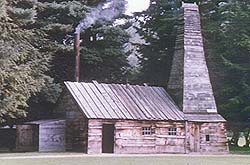 |
||||||
First Production
It was the next day, Sunday, August 28, that Billy Smith and his young son Samuel looked into the hole from which they had pulled the tools the night before. Crude oil was rising in it. No gusher here. Smith grabbed a piece of tin eave's spouting, rolled it, plugged one end, then lowered it on a string and retrieved the first oil from the well. After that, the oil was brought to the surface via a borrowed hand pitcher pump, the type used for farm water wells and sinks. The pumped oil splashed into a washtub!
There are many accounts of the daily production of Drake's well, but most of them could be estimates and guesses. Ida M. Tarbell (1938) summed up the first twenty-four hours' production at twenty-five barrels by the pump. There are mentions of 40, 20 and 10 barrels per day in the literature. Dickey (1959) wrote that the well made about 10 barrels daily for a year or more. In any case, Drake had soon used up all the empty whisky barrels available in Titusville. His well then became the first incentive for the many cooperages which sprang up in the Oil Creek region.
The production declined. Eventually the well was idle and known as the "Old Drake Well" to the many oilmen who traveled past it in their haste to drill farther down the creek.
 |
A friend of oil region photographer John A. Mather stands at the casing head of the abandoned Drake Well in 1896. Photo from Drake Well Museum. |
 |
Replica of engine house and derrick at the Drake Well Site. Meticulously planned from 1860's photographs, it was dedicated in 1946. It now contains a working replica of the original boiler and engine. |
![]()
| © 2004, Samuel T. Pees all rights reserved |
|